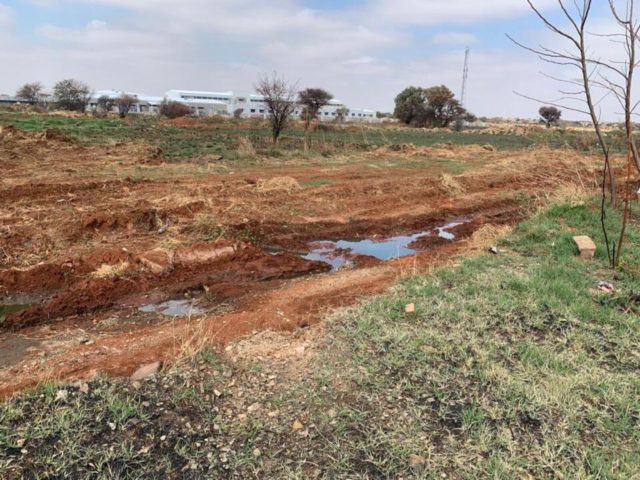Sol Plaatje Municipality has stopped hospital’s technical team from “proactively managing” pumps it installed at sewage station
WHILE the Sol Plaatje Municipality is preventing technicians from Mediclinic Gariep from accessing the two pumps the hospital group installed at the Petrus Street sewage station in 2014, raw sewage is now flowing into the veld near the medical facility, creating a health risk.
Hospital spokesperson Denise Coetzee explained that the hospital had provided and installed two pumps at the station in 2014, as well as upgraded the electrical infrastructure, at a cost of half a million rand.
Two pumps were installed not only to increase capacity but also to ensure that there was always a standby pump available if necessary.
“Prior to construction of the hospital, Mediclinic Gariep paid for two pumps to be installed at the pump station to manage capacity, as well as replacing the electrical panel. As an additional measure, through a verbal agreement with the municipality, a technical team from Mediclinic had access to the plant to proactively manage the pumps,” Coetzee said.
According to Coetzee, this access has since been withdrawn. “The municipality informed us in 2018, that we would no longer be able to access the site and the locks were changed.”
The municipality indicated that it would manage the pump station itself.
The Petrus Street pump station has a mechanism that controls the sewage levels and while the problem with capacity has been an issue for several years already, in the last six months the situation has deteriorated even further.
Currently only one pump is working at the station, resulting in repeated blockages and raw sewage overflowing in the surrounding areas.
Part of the agreement with Mediclinic was to allow the hospital’s technical staff to manually switch on the pump station three times a week to prevent the sewage from overflowing.
“Mediclinic Gariep is aware of the long-standing issues regarding the processing of sewage in Petrus Street by the Sol Plaatje Municipality,” Coetzee stated.
“The environmental risk to the community and the hospital is a big concern to us and although it is not the responsibility of the hospital to manage the problem, as a corporate citizen we have to stand with the local community to tackle this issue. We believe that we have undertaken all measures possible to mitigate the potential impact on our community even though it is the responsibility of the municipality.”
According to residents in the area, the raw sewage often flows into the road and has even flooded nearby houses.
It has also corroded the tar, resulting in massive holes in the tar road, while residents have pointed out that the stench is often unbearable.
Coetzee pointed out that repeated attempts had been made to engage with the Sol Plaatje Municipality as well as the mayor, Patrick Mabilo, but to no avail. “They undertake to send someone out but this seldom happens.”
In the meantime, the municipality has dug a trench from the pump station to the veld next to Mediclinic to divert the overflowing sewage.
This has resulted in the formation of a swamp of sewage in the veld and concern has been expressed by the hospital group on the impact this will have as it is a health danger, while it also poses a risk of infection.
“We understand the impact this matter has on our community and as a result Mediclinic has also escalated the issue to the Northern Cape Chamber of Commerce and Industry (Nocci) to manage on behalf of all the businesses within the affected area. We believe that the Green Hawks also received complaints on this issue and are busy investigating,” Coetzee said.
The sewage problem in the area has been ongoing long before Mediclinic Gariep Hospital opened, as the existing pump station did not have the necessary capacity to service the area and was old.
Since the hospital opened in 2014 there has been considerable development in the area, resulting in an increased population relying on the current infrastructure. This includes a number of large townhouse complexes, including those in Queensway, as well as a new housing development in Minerva Gardens.
At a Sol Plaatje spelum meeting in 2017 already, the municipality admitted that the Petrus Street pump station had reached its capacity and any additional inflow of sewage would influence the sanitation services in the area negatively.
It stated further that it was in the process of upgrading the existing pump station in order to accommodate new development in the area, but added that the commencement of the upgrading of the pump station could not be confirmed at the time and was subject to the availability of funds.
Sol Plaatje spokesperson Sello Matsie said on Tuesday that both Carters Glen and Hillcrest sewage pump stations had reached their design capacity and warranted the need for the construction of the Carters Ridge sewage pump station.
“Once the Carters Ridge pump station has been constructed, both the existing pumps stations will be decommissioned and all areas will operate from the one new pump station,” said Matsie.
He added that the Carters Glen pump station had been subjected to vandalism, while operational challenges were pertinent at the Hillcrest pump station.
“The new project will address the challenges experienced, however, the project has only started with the construction phase.”
Matsie stated that as an interim measure, an additional pump would be installed at Hillcrest pump station to address the current issues.








